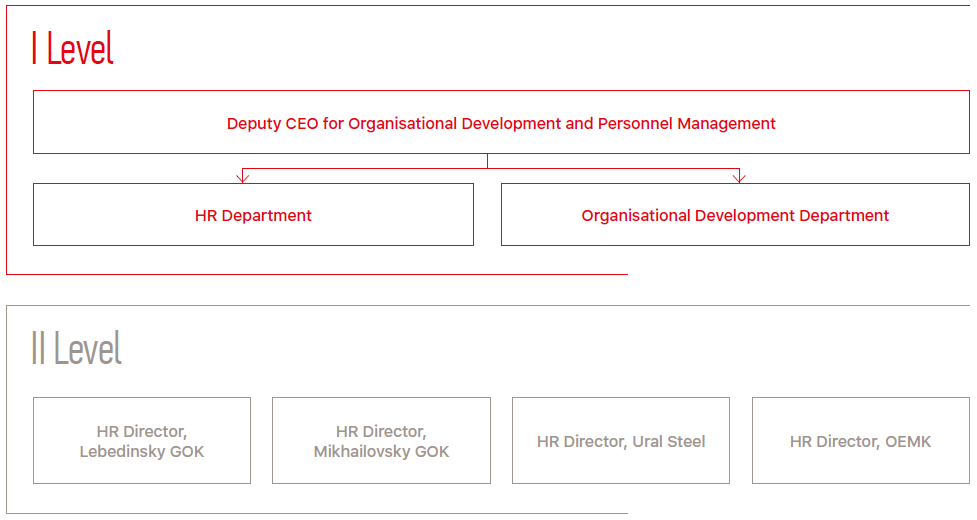Personnel Management System

The Company has two organisational levels of personnel management. The first level includes two departments: the Organisational Development Department and the HR Department, which report to the Deputy CEO for Organisational Development and Personnel Management. The departments’ tasks include developing goals and strategies concerning staff management as well as training direct managers at the enterprise on best practices in staff management.
The Organisational Development Department conducts an assessment of the staff structure, plans the need for new staff, and searches for ways to increase labour productivity and the efficiency of organisational structures. In addition, the Department’s responsibility includes developing a performance management system, setting goals, tracking progress in achieving goals, and adopting decisions once goals are achieved.
The HR Department’s functions involve recruiting staff and developing an incentive system and the methodology for solving HR issues.
Direct staff management is carried out at the second level and falls within the responsibility of line managers who are in charge of operations at Metalloinvest plants.
In this segment, a separate role is assigned to the Social Policy Department, which reports to the Director of Corporate Communications and Social Policy. The department deals with issues concerning social support for staff, establishing and providing discount packages for employees, engagement with trade unions, and drawing up a collective bargaining agreement.
The two-tier personnel management system makes it possible to more flexibly respond to the needs of employees and ensure regular engagement with staff and a high level of involvement by all parties in the process.
The Multifunctional Shared Services Centre (MF SSC) has been the auxiliary unit that manages human resources issues since 2017. All operational accounting issues, such as HR administration and salary transaction, are among the key functions of the MF SSC.
Key corporate documents governing staff management:
- Regulation on Talent Pool Management
- Regulation on Employee Salaries and Bonuses
- Regulation on Social Support for Workers and Their Families
- Concept of Non-Financial Incentive Tools
- Regulation on Reward Activities
- Regulation on the Performance Management System (KPI: goal setting, tracking, and summarisation)
- Regulations on organisational structures
- Regulations, rules, and standards for work at plants required to undergo ISO certification as well as internal and external audits
- Regulations on the training and development of the METALLOINVEST Group’s employees
Metalloinvest invests in the development of the personnel management system with the aim of transforming the practice into an effective mechanism to ensure the effectiveness of economic activities. In an effort to comply with best practices, the Company regularly exchanges experience with other members of the metals and mining sector and conducts a comparative assessment of its activities with similar activities of market leaders. The results of this analysis are actively used to improve the Company’s HR system.
One initiative to improve the efficiency of staff management was the introduction of the SAP Human Capital Management system (SAP HCM, alternatively SAP HR), which took place in record time for the perimeter in which it was introduced (four enterprises). The SAP system is scheduled to be fully introduced by July 2019.
Introduction of the SAP HCM
The introduction of the SAP system offers a number of technical and organisational advantages.
From a technical standpoint, the system, which unites all the holding’s enterprises, makes it possible to ensure easy, transparent, and reliable access to the data of each plant.
From an organisational standpoint, the introduction of the unified system requires the Company to review, unify, and standardise all business processes. In particular, due to the implementation of SAP HCM, the following results were achieved during the reporting period:
- 140 organisational units were reorganised;
- the internal corporate transfer of 43,000 employees;
- a reduction in the number of management levels from thirteen to seven;
- the span of control (the number of people managed by a manager) was expanded from seven to twelve people.
The reorganisation has considerably simplified and accelerated the process of adopting organisational decisions.
Plans for 2019 and the mid-term
In the medium term, the Company plans to reorganise its support functions, in particular the units that handle maintenance and administrative support for production activities, due to changes in and the centralisation of business processes.
The Company also plans to automate processes outside the perimeter of the current SAP HCM module. In addition to automating staff and transactional issues as well as time cards and self-service for directors and managers, there are plans to automate the process of setting goals and key performance indicators for employees, the knowledge management and training system, and procedures for working with the talent pool.






